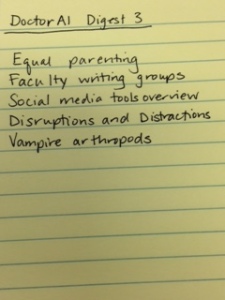This blog post was prompted by a disturbing post over at Tenure, She Wrote by a graduate student talking about the lack of funding for conferences. I am happy to say that my experiences of conferences as a graduate student were not like the experience that this student is describing, but I was horrified by the situation detailed in the blog post.
I’m now a PI and my goals with regards to graduate student travel funds are to be as transparent and fair with my graduate students as I can be. It is what I would like a supervisor to do for me if I was still a graduate student. Since starting my position 5 years ago, I have had an unwritten policy on this topic, but this student’s post made me realize that I should be more explicit in my policy and perhaps write it down so that there is less chance of a miscommunication with one of my students.
My goal for each of my graduate students is to send them to 1 conference per year of their program. Most of my students complete their program in 2 years, so this usually means two conferences. Usually the first conference is local and therefore lower cost and they usually present on work in progress at this meeting. These are smaller meetings where I am able to help them network and the attendees are friendly. The second meeting involves the presentation of the full story of their thesis work and I try to ensure that this is either a national meeting or an international one. This is my philosophy on meetings. I allow my students to present work in progress or partial stories at the first meeting and I know many PIs who don’t do this; I feel that the experience is worth it for the students even if the work doesn’t yet represent a full story. I tell my graduate students several times during the year that my goal is to send them to one conference per year. If students wish to attend more conferences, then we discuss their reasons for attendance and negotiate my financial contributions based on grant funds available.
I also have a very explicit conversation with my graduate students near the beginning of their program about how the costs of the conference will be handled. I pay for all travel, accommodation, meals, posters, and registration costs. If I can charge the cost directly to my grant (usually using an institutional credit card) I do so. If the cost gets charged upon arrival at the conference I either charge it in person upon arrival, issue the student a travel advance, or if the student is comfortable with it they charge it on their own credit card and get reimbursed. Fortunately our institution is fairly speedy with reimbursements, so students do not have to pay interest on the amount or carry the balance for more than two weeks after our return from the conference. I let the students tell me what they are comfortable with and I don’t judge. I let them know that if funds are tight, we will come up with a solution that works for both of us and that they should not place themselves in financial hardship to attend a conference. If the student wishes to pair travel to a particular location with a vacation and stay for a bit before or after the conference, then I still pay for the return trip, but during those extra days they are responsible for their accommodations and food and I explain that clearly before we make any travel bookings. I also ask my students to apply for all available travel grants that they qualify for to help support their attendance, but these funds do not make or break the trip.
As a graduate student I often had to share rooms with other students. At times this was fine and I expected it and at other times it was awkward (e.g. when I was pumping milk while still breast feeding). I initially ask students if they are comfortable sharing a room or a suite of rooms with other students. Residence and hotel options differ quite a bit and I ask my students to explore all options and let me know their preferences. I have had students who preferred their own room with a washroom, students who share a room and washroom with one other student, students who share a suite with other students (they have their own room, but share 1-2 washrooms with others), students who have their own room and share a communal washroom on the floor, etc. I respect the requests of my students and I assume that they have logical reasons for any limitations that they place on housing arrangements. I do not share accommodations with my students as I am not comfortable with that arrangement.
Affording all graduate students with the opportunity to participate in conferences is one of the commitments that I make to each student that I accept into my laboratory. Whether or not they can financially afford it should not dictate whether they can attend. I consider this philosophy one of the privileges and responsibilities of mentoring graduate students.
How do other people handle conference costs for their graduate students? Any horror stories that you’d like to share?
